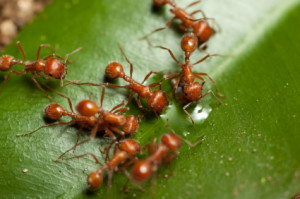…And What You Can Do to Stop Them
 There’s nothing worse than putting the finishing touches on a cool, green expanse of springtime grass and promptly finding an insect or arthropod infestation within its confines. Unfortunately, the San Antonio area is home to many lawn-destroying pests that cause serious financial and time-management problems for local homeowners. Learn more about the most common types of lawn-eating insects and the steps you can take to limit the damage they cause.
There’s nothing worse than putting the finishing touches on a cool, green expanse of springtime grass and promptly finding an insect or arthropod infestation within its confines. Unfortunately, the San Antonio area is home to many lawn-destroying pests that cause serious financial and time-management problems for local homeowners. Learn more about the most common types of lawn-eating insects and the steps you can take to limit the damage they cause.
Fire Ants
Few insect species cause as many problems for San Antonio-area homeowners as the dreaded fire ant. These critters establish extensive colonies in sunny, open spaces, including cultivated yards. Fortunately, fire ant infestations are immediately recognizable: Each infestation produces at least one conical mound that can reach over a foot in height.
While fire ants don’t feast on turf grasses, they can weaken your lawn’s root structure and create unsightly dirt patches. To get rid of them, consider introducing a nematode colony into the surrounding soils. These tiny worms love to eat ants and their larvae. Alternatively, carefully pour boiling water down the mouth of each fire ant mound after a soaking rainstorm. This could fatally weaken the colony.
Chinch Bugs
These tiny, winged bugs live amid your lawn’s grass and tirelessly feed on its vulnerable blades. While they prefer St. Augustine grasses, they’ve also been known to attack other varieties. Since chinch bugs are small and often scattered, it can take some time to recognize an infestation. Over time, you’ll begin to notice yellow or brown patches of grass that radiate outward from the infestation’s core. To get rid of these critters, put out a bird feeder near the infestation or introduce big-eyed bugs to your lawn. These larger animals love to eat chinch bugs. Carefully applied insecticides may help as well.
Slugs
While slugs move quite slowly, they’re voracious eaters. It only takes a few slugs to cause serious damage to your lawn. If you notice dying patches of grass or damaged vegetable plants, fill a container with fruit cores or rinds and place it near the affected area. Overnight, slugs will gravitate to these baits and away from your yard. In the morning, simply dispose of the containers and get on with your day.
Grubs
Grubs live in moist soils or decaying plant matter near readily available sources of food. These white, shapeless beings love the roots of buffalo, St. Augustine, Bermuda and zoysia grasses. Although they’re only active during the late summer and fall, they can cause serious damage within short time frames. Like ant colonies, grub infestations can be treated with nematodes.
If you’re dealing with a serious insect infestation in your lawn or garden, simple prevention and containment measures may no longer be enough. To explore the full measure of your pest control options, call us at (210) 599-9500 or visit our homepage for more information and a free estimate.